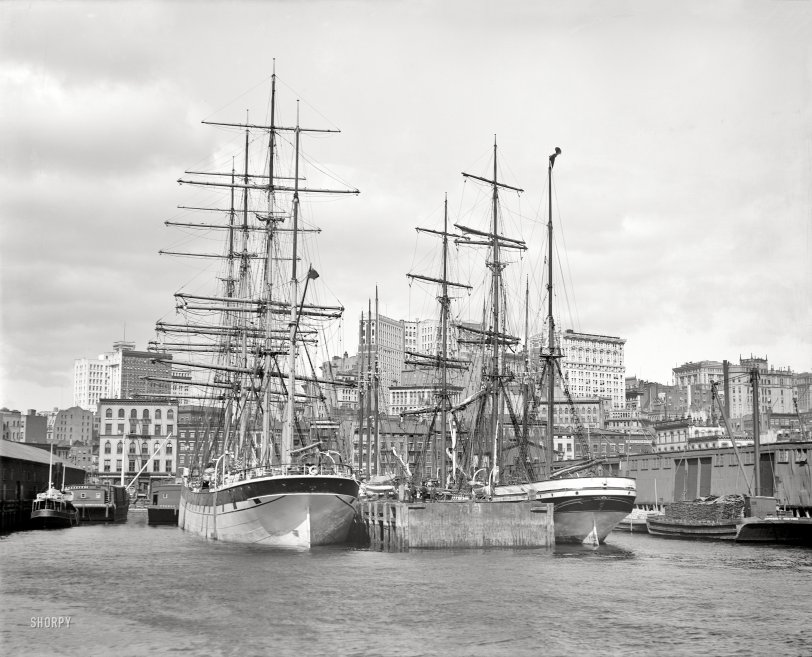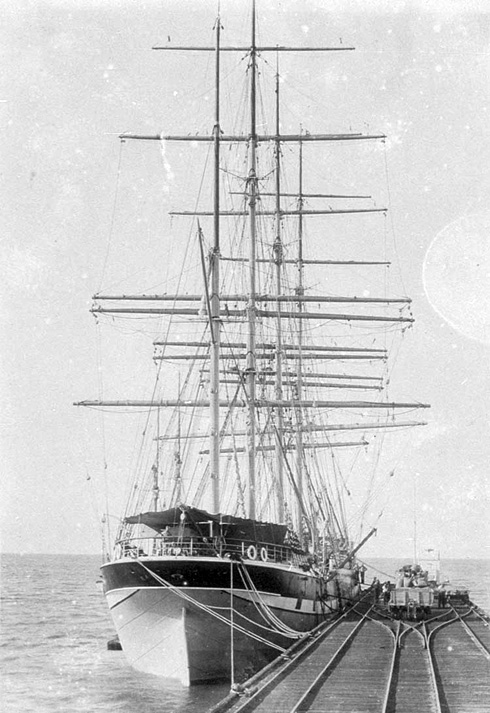


Framed or unframed, desk size to sofa size, printed by us in Arizona and Alabama since 2007. Explore now.
Shorpy is funded by you. Patreon contributors get an ad-free experience.
Learn more.

- Baldwin 62303
- Baldwin VO-1000
- Cold
- No expense spared
- Tough Guys
- Lost in Toyland
- And without gloves
- If I were a blindfolded time traveler
- Smoke Consumer Also Cooks
- Oh that stove!
- Possibly still there?
- What?!?
- $100 Reward
- Freeze Frame
- Texas Flyer wanted
- Just a Year Too Soon
- WWII -- Replacing men with women at the railroad crossing.
- Yes, Icing
- You kids drive me nuts!
- NOT An Easy Job
- I wonder
- Just add window boxes
- Icing Platform?
- Indiana Harbor Belt abides
- Freezing haze
- Corrections (for those who care)
- C&NW at Nelson
- Fallen Flags
- A dangerous job made worse
- Water Stop
Print Emporium
Nautical New York: 1900

New York City circa 1900. "Shipping at East River docks." More maritime Manhattan. 8x10 glass negative, Detroit Publishing Co. View full size.
One's still there
Most of those buildings are long gone, but the one at center, beyond the three closely-spaced masts in line with the right edge of the Earl of Dunmore, seems to still be there (mostly, anyway) at the SE corner of Broad St and Exchange Place.
It's the bldg at the right edge of another Shorpy pic.
The narrow slab extending toward the camera from that building has been demolished in the last few years.
A 1927 view of the building, in the lower left corner of the aerial pic.
Barque Earl of Dunmore
Launched 1891 on the River Clyde. Rigged with double top and topgallant sails.
Journal of the Royal Naval Reserve, 1892.Earl of Dunmore, ship; outbreak of fire at Chittagong, January 5, 1892, when laden with jute. Inquiry held at Chittagong, February 6, 1892. Fire apparently intentional. Conduct of stevedore suspicious.
Round the Horn Before the Mast, 1902
By Basil LubbockFriday, 21st July, 1899, San Francisco. —
The four-mast barque Earl of Dunmore came into the wharf next to us this morning, fifty-two days from Newcastle, Australia. She is nothing like such a fine ship as the Royalshire; though her tonnage is greater, her masts and spars are half the size of ours. She is a Glasgow-built ship, like the Royalshire, and is overrun by a wild crowd of Scotch apprentices.
The Hobart Mercury, August 15 1903.A London Ship on Fire in Sidney Harbour.
A Sensational Scene.
SYDNEY, August 14 … The barque Earl of Dunmore, which arrived from London on Sunday, and is lying off Chowder Bay, was discovered to be on fire at 2 o'clock this morning.
Included in the cargo was 130 tons of dynamite and gunpowder, and the crew lost no time in attacking the flames, but in spite of their best efforts the fire, which gained a firm hold on the cargo of the forehold, spread fiercely and rapidly. In this hold was stored a large quantity of inflammable material including oils, turpentine, and tar. This caused dense pungent smoke in great volume, which hampered the efforts of the seamen.
There are four hatches on the vessel, all of which have been nailed down, and nobody has been below for several days. Captain Menke, his wife and child were transferred to the pilot steamer for safety. A steamer with the Harbour-master on board arrived alongside the burning ship within half an hour of the receipt of alarm, and directed salvage operations. Powerful pumps on the Harbour-master's boat poured water equal to 2,000 gallons per minute into the hold In which the fire was raging, but the flames made headway. A lot of cargo was stowed on deck, and much of this caught fire.
The sailors, in order to avert the danger where it presented itself of the fire running along the decks, seized burning bales and cases, and threw them over-board. When the deck cargo was cleared away there was a much better chance of getting at the seat of the outbreak, but the fire had the mastery for a very long time. Presently the flames spread to the vessel's rigging, and the decks began to grow hot. Captain Menke ordered that the decks should be cut away, in order to afford more access to the burning cargo, but as soon as the sailors chopped away some of the planking they found iron sheathing underneath.
It was decided at 4 o'clock, as the flames stall raged with undiminishable fierceness and the weight of water poured into the hold was beginning to cause the vessel to sink at the bows, to beach her. Pumping operations were temporarily discontinued, and a steel hawser having been passed to the tug Hero, with some difficulty the vessels anchor was freed from the bottom, and partly lifted, and the Earl of Dunmore was slowly towed towards Rose Bay, where she was beached.
The ship had in her forward hatch a quantity of wax matches and underneath was stored a quantity of oils and other cargo equally combustible. It is presumed that rats got at the matches, and caused the conflagration.
The Melbourne Argus, December 19, 1908.Earl of Dunmore.
Furious Gale.
An adventure which is not likely to be soon forgotten by her crew befel the four-masted barque Earl of Dunmore, on her voyage to this port from Fredrikstadt, Norway. Whilst “running down her easting” across the Southern Ocean the barque was sorely tried by a terrific Westerly gale accompanied by seas which Captain Mencke describes as the highest and most dangerous that he has experienced for many years. Gigantic billows swept the decks from poop to forecastle at frequent intervals threatening serious injury to the ship, and necessitating extraordinary vigilance on the part of the crew to escape danger. The disturbance arose on the 20th November, in lat. 42deg. south and lon. 6Odeg. east, lasting, without abatement for a whole day The use of oil to quell the seas was freely resorted to, large quantities being poured over the vessels sides; but despite this expedient, heavy bodies of water thundered over her as she sped before the gale. All movable objects on deck were dashed about in the flood whilst some disappeared overboard on the receding billows. A complete clearance was made of the galley … pots, pans, and other cooking utensils being washed out of the apartment to the unspeakable dismay of the cook. Several of the crew were thrown down by the seas and narrowly averted meeting with serious injury, a few bruises and scratches being the only ill effects. In the meantime squalls of alarming intensity completely drowned the voices of officers and crew until ultimately the storm gradually “blew itself out,”and affording them breathing space. The Earl of Dunmore which is laden with timber met with such light and baffling winds in the earlier stages of her voyage that she did not cross the equator until the fifty-eighth day out. Quite a different experience, however, then awaited her, and she made a capital run of 46 days from the line to Hobsons Bay averaging 220 mile per day for this period, and thus converting what promised to be a protracted voyage into a good one. On her previous voyage to Melbourne the Earl of Dunmore accomplished a splendid passage of 78 days from New York. Captain Menke who is in charge of the vessel, is accompanied by his wife.
British ship. "Earl of Dunmore"
Submitted by Scotsman on Tue, 10/15/2013 - 5:45am.British ship. "Earl of Dunmore" in both pictures above, is on the left in top picture, where I believe she is lying at 19th street or pier 11, east river New York. the lower image is of this ship at Port Pirie S. Australia circa 1894.
Earl of Dunmore was under command of a Shetlander (Capt. T. Kay) from her completion in 1891 - 1903.
I am currently working on a scale model of this ship at 1-48 scale, and also writing up the history of ship and master, any one who has any information on this ship or information on anyone who sailed with her I would be delighted to hear from them, or if I can help anyone interested in the same I will do my best.
my e-mail is. joekay18@gmail.comEarl of Dunmore
Submitted by ChrisL on Mon, 05/07/2012 - 9:17pm.It was sunk by a German submarine in 1917 according to one source. I found this picture of the ship. There are small differences, but the paint scheme is the same. Opinions?
Earl Of ???
Submitted by stanton_square on Mon, 05/07/2012 - 6:59pm.I'm having the hardest time reading the name on the transom of the vessel tied up to the south of the pier. I would guess the ship to be a commercial barque but hopefully someone more expert in rigging will step in to correct the record. Of the name, the left side looks possibly to be "Earl of" but I can't piece out the rest. It's a bit like trying to read the 7th line of the Snellen eye chart without my glasses.


























On Shorpy:
Today’s Top 5